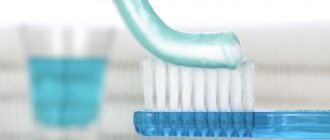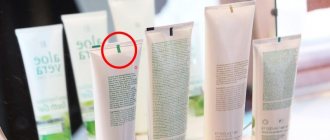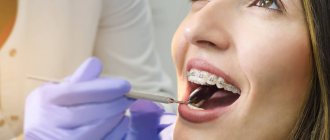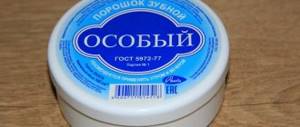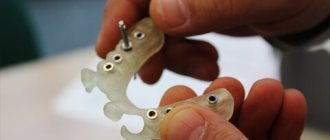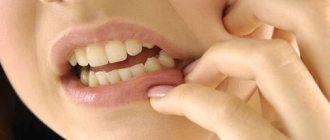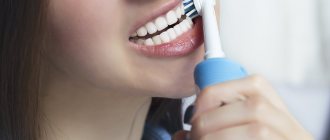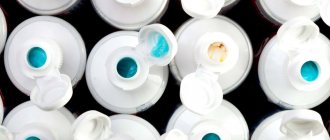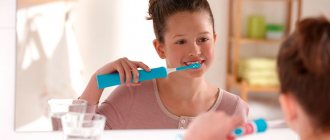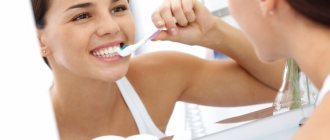Sorbitol has a mild sweetening effect and has some additional properties. Used in the pharmaceutical, food and cosmetic industries, laxatives.
It is added to toothpastes because of its sweet taste; this eliminates the use of sugar, which prevents the development of caries. Thanks to such effects, the texture acquires a pleasant taste.
Composition of toothpastes
The contents of pastes vary depending on the manufacturer, price and type. In addition to water, the main components of hygienic, therapeutic, preventive and specialized products are abrasive substances (aluminosilicates, silicon dioxide, calcium carbonate). They perform the main function of all toothpastes - cleaning and polishing teeth.
Specialized products are divided into:
- Anti-caries . They contain fluorides, xylitol, calcium glycerophosphate, phosphorus, and sodium bicarbonate.
- Pastes for sensitive teeth . Contains potassium chloride and nitrate, silicon oxide, strontium chloride.
- Anti-inflammatory . May include aluminum lactate, herbal extracts, hexiditin, chlorhexidine, triclosan.
- Whitening . Produced with silicon hydroxide, sodium and potassium pyrophosphates.
- Sorption . The active ingredient is enterosgel.
Most pastes include viscosity agents, colors and flavors. The latter can be natural (essential oils, menthol, limonin) and artificial.
Foam is created by surfactants, the use of which in products is permitted in an amount of no more than 2%. Of these, manufacturers give preference to sodium lauryl and sodium laureth sulfates. Binders (pectin, glycerin, dextran, cellulose) help to give the paste uniformity.
What is sodium lauryl sulfate
Sodium lauryl sulfate (SLS) is an anionic surfactant whose main properties are to dissolve fats, cleanse, form foam and wet.
The cleansing function of lauryl sulfate is its ability to oxidize, which is why after using cosmetics with SLS a film remains on the skin and mucous membranes. Its effects are manifested by the following symptoms:
- rash;
- redness;
- irritation;
- peeling;
- allergic reactions.
In addition, the water-fat balance of the skin is disrupted and sebum production is stimulated. Lauryl sulfate easily enters the internal organs through the epidermis, accumulating in them. The kidneys, heart, liver, brain and especially the eyes can be affected. The chemical affects the protein tissue of the organs of vision, causing cataracts.
SLS has not been proven to be carcinogenic, but it is known that it can cause cancer when it reacts with other substances. In men, SLS can lead to decreased fertility.
Where there is?
Toothpastes containing sodium lauryl sulfate include:
- ROCS – with chocolate and berry flavors.
- Blend-a-med.
- Colgate.
- "New pearls".
- "Forest Balsam"
- Aquafresh.
- Marvis.
Crest 3d white paste contains sodium lauryl sulfate. It is advisable not to constantly use products containing this component. There are effective products without this substance. Crest 3d white also contains polyphosphates, which loosen tartar, wash it out, and also remove the enamel itself. The product is abrasive.
What is sodium laureth sulfate
Another aggressive component of household chemicals and cosmetics is sodium laureth sulfate (SLES). It is especially valued by manufacturers because, being cheap, it creates thick foam and the illusion of an economically consumed product.
Sodium laureth sulfate irritates the oral mucosa and epidermis, especially in people with sensitive skin and allergies.
Like SLS, it reacts with other ingredients in skin care products to form dioxins and nitrates, and increases the risk of cancer. Laureth sulfate, like its analogue, suppresses the immune system and destroys skin proteins.
At first glance, it seems that both types of sulfates cause the same harm to the skin, hair, mouth and internal organs. But laureth sulfate (SLES) has a less aggressive and irritating effect on the skin, although it dries it more. Its side effects on the body are lower than those of lauryl sulfate (SLS).
Why are SLES and SLS in pastes?
SLES and SLS are anionic surfactants whose molecules are attached at one end to a water particle and at the other to a fat particle. Therefore, sodium sulfates have excellent degreasing and cleaning properties. They have neither taste nor color and dissolve well in water. With magnesium and calcium salts they create poorly soluble substances that form plaque.
Lauryl sulfate is made from lauryl acids (fatty acids from coconuts) by reaction with sodium carbonate and sulfuric acid. Instead of natural raw materials, synthetic ones based on petroleum products are often used. Laureth sulfate (SLES) is obtained by modification of SLS.
Sodium lauryl and laureth sulfates are added to care products for strong foaming. It is thanks to them that a pea-sized amount of paste creates a mouthful of foam. When brushing your teeth, SLS and SLES penetrate the blood vessels of the mouth and are carried throughout the body. This is explained by the increased ability of oral tissues to absorb.
Sodium sulfates in toothpaste have a negative effect on teeth, namely:
- thin the enamel;
- aggravate gum sensitivity;
- dry the oral mucosa;
- provoke stomatitis.
They enter the gastrointestinal tract by ingestion and cause disease. No matter how thoroughly a person rinses his mouth after brushing his teeth, a small amount of the product still penetrates the stomach. This can also happen during oral hygiene. According to research, people swallow about 2.5 kg of toothpaste during their lifetime.
Functions
Why are SLES and SLS in pastes? These components are anionic surfactants. Their molecules are fixed at one end to a particle of water, and at the other to fat. Therefore, sodium sulfates have an excellent degreasing and cleaning effect. They have no taste or color; they dissolve perfectly in water. With the help of magnesium and calcium salts, poorly soluble substances are created that form plaque.
Lauryl sulfate is made from lauryl acids using sodium and sulfuric acid. In addition to natural raw materials, synthetic ones from petroleum products are often used. SLES is created by modifying SLS. Components are added for foaming. It is with their help that a small amount of paste provides a mouth full of foam.
When brushing your teeth, substances enter the blood vessels of the mouth and are carried throughout the body. This is due to the high absorption capacity of oral tissues. Why is sodium lauryl sulfate harmful? Because of this component:
- enamel becomes thinner;
- gum sensitivity increases;
- the oral mucosa dries out;
- stomatitis appears.
The components penetrate into the gastrointestinal tract when swallowed and lead to diseases. Even if the mouth is rinsed thoroughly, some of the product ends up in the stomach. This also happens during oral hygiene.
Where else is SLES and SLS used?
Initially, sodium sulfates were used in industrial cleaning agents for machines and mechanisms, for degreasing engines and various surfaces.
In medicine, substances have found use as skin irritants for experimental purposes. In this way, scientists tested the effectiveness of drugs to relieve irritations.
Sulfates are most widespread in the production of household chemicals, decorative and caring cosmetics. About 90% of all shampoos contain sodium lauryl and laureth sulfates. Also, these elements are often found in shower and wash gels, shaving foam, dishwashing liquid, makeup remover and intimate hygiene, washing powders, and liquid soap. Sulfates in creams and products that are not washed off the skin are especially harmful.
What are parabens in toothpastes?
Parabens are found in almost all dental care products. They act as preservatives, extending the shelf life of the product.
On the packaging of the product they are indicated by the following names:
- methylparabens;
- propylparabens;
- butylparabens;
- ethylparabens.
They are allowed to be added to cosmetic products in an amount of no more than four tenths of a percent of the total weight of the product. Scientists have proven the involvement of parabens in the incidence of breast and reproductive organ cancer.
This is explained by the fact that their accumulation in the body causes an excess of estrogen and changes hormonal levels. Also, preservatives in hygiene products cause allergies and corrode the skin, interfere with the DNA structure, and accelerate aging.
ROCS Active Calcium toothpaste - new opportunities in preventive dentistry
May 8, 2014
Among the adult population of our country, it is very difficult to meet a person for whom the problem associated with dental caries would be unfamiliar. One of the reasons for the development of caries is the weakening of the physiological mechanisms of maintaining tooth mineralization at an optimal level. This is due to changes in the diet of modern people, which is shifting towards the predominance of easily fermentable carbohydrates in the diet, with the deterioration of the environmental situation, as well as with a number of other reasons, the result of which is chronic stress and a decrease in local immunity. The microelements contained in teeth and changes in their composition and concentration, often significant, are in close connection with age, the condition of the teeth (intact, affected by caries or periodontal disease), the state of the body and other factors.
Under natural conditions, the source for the entry of its main structural elements into the enamel - calcium and phosphorus - is the oral fluid. However, the remineralizing potential of saliva allows stopping caries at the spot stage only in 50% of cases (Kuzmina E.M., 2001). Therefore, to increase the caries resistance of enamel, it is necessary to use personal oral hygiene products that include components that increase its mineral saturation.
It has been established that gels containing soluble calcium salt and soluble phosphate-containing salt, prepared ex temporo, have proven to be an effective means of preventing and treating initial forms of caries. In addition, recently there has been evidence that the remineralization process is supported enzymatically, in particular, the inclusion of phosphates and calcium in tooth enamel under the influence of phosphatases is significantly activated. The activity of these enzymes increases in the presence of chlorine and magnesium ions (Bochkareva O.I., 2003). The substrate for alkaline and acid phosphatases is calcium glycerophosphate. As a result of its hydrolysis under the influence of an enzyme, calcium and phosphate ions are released, as well as some energy, which is believed to be used to transfer the ions to the tooth enamel.
Studies conducted at the Central Research Institute of Dentistry using immobilized alkaline phosphatase have demonstrated that it is in the presence of glycerophosphate that the mineralization process of teeth is most successful. The reason for this may be a greater acceleration of the formation of apatite under the action of immobilized alkaline phosphatase than brushite or whitlockite (Zhitkov M.Yu., 1999). The inclusion of calcium glycerophosphate and magnesium salts (for example, chlorides) in the composition of toothpastes would allow for a pronounced positive effect on mineral metabolism in tooth enamel.
Long-term fundamental research of beaver incisor enamel, resistant to caries, carried out under the guidance of Professor A.A. Kunin of the Voronezh State Medical Academy. (2011) demonstrated that high levels of microhardness of tooth enamel depend on an increased content of microelements such as magnesium, sodium, potassium, silicon and a reduced content of sulfur and chlorine. The inclusion of microelements such as magnesium, silicon, potassium and sodium in products for the prevention of dental caries in adults will help strengthen the enamel and increase its resistance to acids.
The data from the studies described above were taken into account by specialists from the WDS laboratory when developing the composition of the new ROKS Active Calcium toothpaste. The composition is based on a multimineral complex containing all the minerals necessary for enamel: calcium, phosphorus, magnesium and silicon in an optimal ratio (patent EA 012247). The action of the complex is aimed at strengthening the structure of teeth and increasing their resistance to the influence of negative factors in the oral cavity. This complex does not contain fluoride, and therefore has no contraindications for use (age-related or regional, due to the quality of drinking water). The new paste expands the capabilities of modern preventive dentistry: traditionally, fluoride and/or calcium compounds were used to prevent caries. The development is based on the results of fundamental research into the mineral composition of teeth resistant to caries; the main vector of influence is aimed at optimizing the mineral metabolism of enamel. The high magnesium content helps to increase the inclusion of elements necessary for hard tissues - calcium and phosphorus. Silicon initiates mineralization processes, especially in the early stages, and even with low calcium content, silicon accelerates its absorption. Testing the effect of the complex on the acid resistance of tooth enamel (KOSRE-test), carried out at the Department of Therapeutic Dentistry of the Voronezh State Medical Academy (headed by Prof. A.A. Kunin) confirmed the high effectiveness of the composition.
Due to the widespread prevalence of caries disease among the population, in addition to the task of increasing the caries resistance of hard dental tissues, mineral support of hard tooth tissues after filling is also relevant. Typically, the recovery period after tooth filling is characterized by intense loss of mineral components in the surface layer of enamel, which can serve as a provoking factor in the development of secondary caries. ROX Active Calcium toothpaste, which is a source of bioavailable calcium, allows you to restore the mineral saturation of healthy enamel and enamel after restorations. This property of the composition was confirmed in clinical and laboratory studies carried out under the guidance of prof. Kunina A.A.
To study the effect on the properties of enamel after tooth preparation and filling, fluoride toothpaste and toothpaste with a multimineral complex (calcium, magnesium, phosphorus and silicon) were compared. Under the influence of fluoride-containing toothpaste, an insignificant concentration of calcium ions was detected at the enamel-filling interface, without mutual diffusion of elements, which confirms the relationship between changes in the mineral metabolism of enamel and disruption of its microstructure, and under the influence of a paste with a multimineral remineralizing complex, a significant accumulation of calcium and phosphorus ions was noted in the surface layers of enamel and at the enamel-fill interface; penetration of calcium and phosphorus across the border, which confirms the effectiveness of using toothpaste to restore enamel in the post-filling period and to prevent secondary caries.
To enhance the anti-plaque effect, xylitol (6%) is included in the formula of ROKS Active Calcium toothpaste. This is a natural component that prevents the development of cariogenic microflora and the formation of dental plaque, and also normalizes the composition of the oral microflora. The paste has low abrasiveness, which allows it to be used by people with increased tooth sensitivity and enamel defects. The delightful shine of healthy enamel, pleasant mint taste with bright notes of citrus will complement your acquaintance with the company's new product.
Material provided by DRC
*ROCS RECOMMENDS: Visit your dental hygienist at least twice a year. Visiting a doctor reduces the likelihood of tooth decay and provides protection against periodontal disease.
Tags: ROCS
More on the topic
ROCS – brand of the year!
The group (ROCS brand) became the winner of the 3rd Russian Business Guide. People of the Year 2021.” For the third time, the international magazine “Russian Business Guide”, which is the founder of the award, noted innovative, export and socially oriented businesses, territories that work most successfully and productively with investors.
NEW – children's black toothpaste ROCS Junior BLACK
Natural highly mineralized toothpaste ROCS Junior BLACK “Coconut and Vanilla” is designed specifically for children aged 6 to 12 years. It is used during the period of replacement of milk teeth with permanent ones. The pleasant taste of coconut and vanilla motivates the child to brush their teeth regularly, and the unique composition of the paste, developed with the participation of dentists, strengthens young enamel.
FEMEGYL is the winner of the V National Award for the best perfume and cosmetic products in Russia
The “My Cosmetics” award is a unique project of the Russian perfumery and cosmetics industry, created for the general public and professional audience. One of the winners of the prestigious award was the cosmetics brand FEMEGYL®.
ROCS® Innovation Collection
There are practically no effective hygiene products in the world that would solve the problem of dry oral mucosa. The group, one of the world leaders in the production of quality oral care products, introduced to the market a unique ROCS® PRO Moisturizing toothpaste (moisturizing). We present this and other interesting global innovations of the company in our review.
New remineralizing gel ROCS Minerals BIO
ROCS presents a new product - a remineralizing gel for strengthening teeth of a new generation. ROCS® Minerals BIO combines one of the most effective remineralizing systems and advanced biotechnology. The product does not contain fluoride and is safe to swallow; Suitable for use by both adults and children from infancy.
Innovative product from ROCS: Active Magnesium toothpaste
The formula includes high concentrations of magnesium, a vital chemical element necessary for the functioning of more than 300 enzymes in the human body, including the mineralization of teeth and bones.
ROCS® PRO MOISTURIZING – global innovation in oral hygiene products
There are very few effective hygiene products in the world that would effectively solve the problem of dry oral mucosa. The ROCS team of experts and developers presents a unique ROCS PRO Moisturizing toothpaste. The patented formula of the product has been tested many times in clinical practice and has shown high effectiveness.
ROCS presents a bright summer novelty for children
ROCS specialists have developed a beautiful and comfortable ROCS Junior toothbrush especially for children aged 6 to 12 years. The original design and rich color combinations of the handle and bristles will delight the child and allow him to choose a unique color to suit his mood.
The Russian brand ROCS is available for order on the global iHerb platform
ROCS became the first Russian brand represented by iHerb internationally. The global online store announced the launch of sales of more than 20 ROCS products in all regions of its trading platform presence.
Beauty vibes from Femegyl
Nature gives beauty. Women knew about this many hundreds of years ago. Back then, they collected plants to make extracts and oils for skin care. Now professionals do this for women: cosmetologists, chemical technologists and doctors. Using natural ingredients, they create such effective skin care products as Femegyl Velvety Skin Fluid Serum. Return to section
How dangerous substances are masked in formulations
Often, manufacturers of hygiene products deliberately distort the names of harmful components in the composition and replace them with others. Thus, lauryl sulfate, obtained during oil refining, is often disguised as an analogue extracted from coconuts or coconut oil (Sodium Coco Sulfate).
The inscription “Paraben free” (without parabens) on the label is not always true. The manufacturer may deceive customers by indicating methyl paraoxybenzoate or ethyl paraoxybenzoate in the composition. But this does not change the essence: these substances still remain parabens, although the word “paraben” is not present in their name.
Disguise
How are dangerous substances disguised? Manufacturers often distort the names of harmful components and replace them with others. Lauryl sulfate, which is obtained by refining petroleum, is often disguised as an analogue that is extracted from coconuts or coconut oil.
The label “Paraben Free” on packaging is not always true. Manufacturers often deceive customers by labeling them as methyl paraoxybenzoate. But the essence still remains the same: the components are parabens.
Top 8 most harmful substances in toothpastes
In addition to SLS and SLES, the paste contains many more harmful components, which are also very important to know about.
- Sodium Lauryl Sulfate - SLS . This is an anionic surfactant (surfactant), the main properties of which are to dissolve fats, clean, form foam and wet.
- Sodium Laureth Sulfate - SLES . Another aggressive component of household chemicals and cosmetics. It is especially valued by manufacturers because, being cheap, it creates thick foam and the illusion of an economically consumed product.
- Triclosan . It belongs to the class of synthetic antibiotics and is added to products to combat harmful bacteria. If you frequently brush your teeth with antibacterial agents, the microflora of your mouth may suffer, since beneficial microorganisms are also destroyed along with pathogenic ones. Long-term use of products containing triclosan provokes the progression of tonsillitis, periodontitis and other diseases.
- Chlorhexidine . This antiseptic substance is added to toothpastes to prevent plaque and inflammation of the mouth. Like the previous element, Chlorhexidine destroys both pathogenic and necessary microflora of the mouth, and when it enters the digestive tract it has a similar effect there.
- Fluorine . It is added to dental care products to protect enamel from destruction by bacteria and acids. However, oral hygiene with fluoride products leads to an overdose of this element. This is explained by the fact that fluoride enters the body from many other sources: tap water, food, tea. Buckwheat, rice, oats, apples, citrus fruits, walnuts, fish, seafood, and potatoes are rich in fluoride. The daily fluoride intake for adults is only 2 mg, for children over 4 years old – 2 times less. Exceeding these standards leads to urolithiasis, destruction of bone and joint tissue, impaired memory and thinking, and pathologies of the thyroid gland.
- Formaldehyde . This toxic element can be found in almost all germ-killing products. Getting it into the body can negatively affect vision, skin, liver, kidneys, lungs and even DNA.
- Aluminum lactate . Widely used in inflammation relievers and products for sensitive teeth. By reducing gum bleeding, aluminum salts harm brain cells. This manifests itself in decreased mental abilities, memory, impaired coordination, and dementia. The accumulation of aluminum in the body interferes with the absorption of calcium and phosphorus, which negatively affects the musculoskeletal system.
- Propylene glycol (PEG) . Inhibits the growth of bacteria in the paste. In the human body, it affects the immune and respiratory systems, causing dermatitis, allergies, and dry mucous membranes.
List of the best toothpastes without sodium lauryl sulfate for children
PRESIDENT Baby
The hygiene product is designed specifically for babies from birth to three years. Used to clean the first teeth after erupting. The formulation contains soothing components that care for gums, relieve irritation and inflammation.
To care for enamel, the active formula includes calcium and xylitol. With each application, they make the solid structure more durable. This makes it possible to avoid the formation of caries.
Thanks to the pleasant raspberry flavor, it is possible to instill in the child positive emotions from hygiene procedures.
SPLAT Juicy Set
The toothpaste is designed for children, but can also be used by adults with particularly sensitive enamel. The active complex restores damaged areas of hard tissue, protects the surface from the deposition of soft plaque and prevents the development of caries. Thanks to the Luctatol system, it is possible to get rid of pockets of cariogenic bacteria.
Despite the absence of sodium lauryl sulfate, the products foam well and completely cover the surface of the teeth. This allows for thorough cleaning from contaminants and pathogenic bacterial environments.
ROCS PRO Baby
98.5% of toothpaste consists of components of natural origin. This makes it safe even for newborns. The composition is designed for oral care for children under three years of age. It is used on baby teeth immediately after eruption.
The basis of the product is soft components. They do not cause negative consequences, but effectively cope with the removal of soft and hard plaque. Diseases of baby teeth and their premature removal are excluded. This helps to properly form the jaw and bite.
From the product descriptions it is clear that even in the absence of sodium lauryl sulfate in the composition, it is possible to achieve high hygienic results.
If you find an error, please select a piece of text and press Ctrl+Enter.
How to choose a safe toothpaste?
When buying a hygiene product, you should look at the order of the ingredients in the composition. The higher the concentration of a substance in a product, the closer to the beginning of the list it is listed and vice versa. It is important that all ingredients, not just the active substances, are listed both on the packaging and on the tube. If this is not the case, perhaps the manufacturer is unscrupulous and is hiding something from the consumer.
If you have any doubts about whether to take a product with or without fluoride, you should review your diet and roughly calculate your daily intake of the microelement. It is also important to take into account the fluoridation of tap water and the degree of filtration. In some cities, water is saturated with fluoride in large quantities, and then it is better to abandon fluoride-containing pastes.
Need for cleaning
The oral cavity is considered one of the most exposed areas of the body to the environment. There are a lot of bacteria there. Teeth are designed for mechanical processing of food, that is, chewing foods whose remains get stuck between the teeth. This provides a favorable environment for microorganisms. When a person has not brushed his teeth for a long time, bacteria multiply rapidly and a soft plaque appears.
This plaque negatively affects teeth because it releases acid, which destroys tooth enamel. If you do not clean it off, caries gradually appears. Plaque also leads to the disruption of the natural barrier to infections in the mouth. It also leads to halitosis – bad breath and the formation of tartar. By regularly cleaning teeth from soft plaque, microorganisms will not have a chance to cause caries and other problems.
List of toothpastes without SLES and SLS
No matter how hard manufacturers try to put sulfates in all cosmetic products, products without them still exist. The almost harmless component sodium lauryl sarcosinate is responsible for the foaming in them. Often, sulfate-free packaging is labeled “SLS-free.” But it still doesn’t hurt to read the composition and check that the toothpaste does not contain sodium laureth sulfate and sodium lauryl sulfate or their Latin names (Sodium Laureth Sulfate, Sodium Lauryl Sulfate).
Here is a list of safe toothpastes without SLS and SLES:
- President Classic;
- ROCS (standard, Bionica, Energy, coffee and tobacco, for children);
- Silca Multicomplex;
- Natura Siberica Arctic protection;
- Biomed Superwhite;
- Splat (biocalcium, Sensitive, Sea Minerals, green tea, Organic, Extreme White);
- Grandma Agafya's recipes;
- New pearls with calcium;
- Jason Natural Power smile, sea freshness.
Toothpaste is an important component of oral hygiene. Its role in human life cannot be underestimated. However, if you read the composition, it becomes obvious that in addition to the benefits, it also brings a lot of harm. And irritation of the oral mucosa turns out to be the least of the evils, considering that DNA mutation and the development of cancerous tumors can also be a consequence of brushing your teeth. Fortunately, all this can be avoided by purchasing products without the dangerous substances described above.
Dental products without sorbitol
There are several dental products that do not contain this substance.
Jason Natural Sea Fresh
Stevia extract acts as a sweetener.
This product strengthens teeth without harsh abrasives or irritating ingredients. Made from plant-based natural ingredients, for example:
- mint and parsley extracts for mouth freshening;
- algae from the sea, which is rich in calcium, proteins and antioxidants, to strengthen teeth and gums;
- Aloe vera gel is added to soothe irritated gums.
Splat Special Organic
Splat Special Organic is specially made for sensitive tooth enamel and acts as a strengthener. Contains:
- aloe vera extract, which reduces inflammation and heals wounds;
- calcium lactate - to improve the properties of tooth enamel;
- tea tree extract - has antimicrobial properties, has a beneficial effect on the gums and prevents the rapid formation of plaque on the teeth, breaks it down.
Green People Natural Organic Children Mandarin & Aloe Vera Toothpaste
Remedy for children. It has no sweeteners and is 100% organic.
